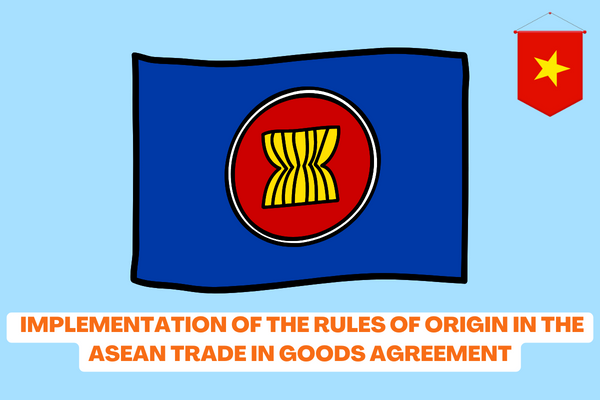Vietnam: What is the implementation of the rules of origin in the ASEAN Trade in Goods Agreement?
Who applies the rules of origin in the ASEAN Trade in Goods Agreement in Vietnam?
According to Clause 2 Article 1 of Circular 22/2016/TT-BCT stipulating the Circular applies to organizations and individuals involved in activities related to goods origins on the ATIGA, including agencies, organizations and individuals participating in activities related to the origin of goods in the ATIGA Agreement.

Vietnam: What is the implementation of the rules of origin in the ASEAN Trade in Goods Agreement?
What are the rules of origin in the ASEAN Trade in Goods Agreement in Vietnam?
According to the provisions of Article 2 of Circular 22/2016/TT-BCT, rules of origin and procedures for issuance, C/O inspection and self-certification of origin of goods are stipulated as follows:
+ Rules of origin (Appendix I).
+ Product-specific rules (Appendix II).
+ Substantial transformation criterion for textiles and textile products (Appendix III).
+ List of ITA products (Appendix IV).
+ Principles and guidelines for calculating regional value content (Appendix V).
+ Guidelines for partial cumulation (Appendix VI).
+ Issuance and verification of Certificates of Origin (Appendix VII).
+ Certificate of Origin Form D (Appendix VIII).
+ Certificate of Origin completion guidance (Appendix IX).
+ List of issuing authorities (Appendix X).
Article 1 of Circular 03/2023/TT-BCT, stipulates amendments and supplements to a number of articles of Circular 22/2016/TT-BCT as follows:
Amending and supplementing a number of articles of Circular No. 22/2016/TT-BCT dated October 3, 10 of the Minister of Industry and Trade of Vietnam implementing the Rules of Origin in the ASEAN Trade in Goods Agreement (hereinafter referred to as Circular No. 22/2016/TT-BCT), amended and supplemented by Circular No. 10/2019/TT-BCT dated July 22, 2019 and Circular No. 25/2019/TT-BCT dated November 14, 2019 of the Minister of Industry and Trade of Vietnam Amending and supplementing Circular No. 22/2016/TT-BCT dated October 03, 10 of the Minister of Industry and Trade in Vietnam implementing the Rules of Origin in the ASEAN Trade in Goods Agreement (hereinafter referred to as Circular No. 10/2019/TT-BCT and Circular No. 25/2019/TT-BCT)
1. Replace Annex II - Item-specific rules in Clause 2 Article 2 of Circular No. 22/2016/TT-BCT (which has been replaced by Annex I in Clause 1 Article 1 of Circular No. 10/2019/TT-BCT) with Annex I promulgated together with this Circular.
2. Replace Annex III - Basic conversion criteria for textile and garment products in Clause 3 Article 2 of Circular No. 22/2016/TT-BCT (which has been replaced by Annex II in Clause 2 Article 1 of Circular No. 10/2019/TT-BCT) with Annex II promulgated together with this Circular.
3. Replace Annex IV - List of information technology items (ITA) in Clause 4 Article 2 of Circular No. 22/2016/TT-BCT (which has been replaced by Annex in Clause 1 Article 1 of Circular No. 25/2019/TT-BCT) with Annex III promulgated together with this Circular.
Accordingly, item-specific rules, basic conversion criteria for textile and garment products and the list of information technology items are changed according to applicable rules according to Appendices II, III and IV issued together with Circular 03/2023/TT-BCT.
What is the definition of some terms in the item-specific rules of the ASEAN Trade in Goods Agreement in Vietnam?
Criteria of origin of goods are specified in the annex issued together with Circular 03/2023/TT-BCT as follows:
- RVC40 or RVC35 means the regional value content of goods, calculated according to the formula specified in Clause 1 Article 5 of Annex I issued together with Circular 22/2016/TT-BCT dated October 03, 10 of the Minister of Industry and Trade in Vietnam, not lower than 40% (percent percentage) or 35% (three lucky gifts) respectively, and the final production is carried out at a water member;
- "CC" means non-originating material converted from any other program to a program, group or subgroup of goods. This means that all data without caustic soda used in the production of goods must undergo HS code conversion at the 2-digit level (Chapter conversion);
- "CTH" means non-originating material converted from any other group to a program, group or subgroup of goods. This means that all non-originating data used in the production of products must undergo HS code transformation at the 4-digit level (group conversion);
- "CTSH" means non-native raw materials converted from any other subgroup to a program, group or group of goods. This means that all non-sourced materials used in the manufacturing process of the product must undergo HS code conversion at level 6 (Partition conversion);
- "WO" means a commodity that has an induction output or is wholly produced in the vacant land of a water supply member.
- Textile and garment rules are rules listed in Annex II issued together with Circular 03/2023/TT-BCT.
Circular 03/2023/TT-BCT will take effect from April 1, 2023.
LawNet